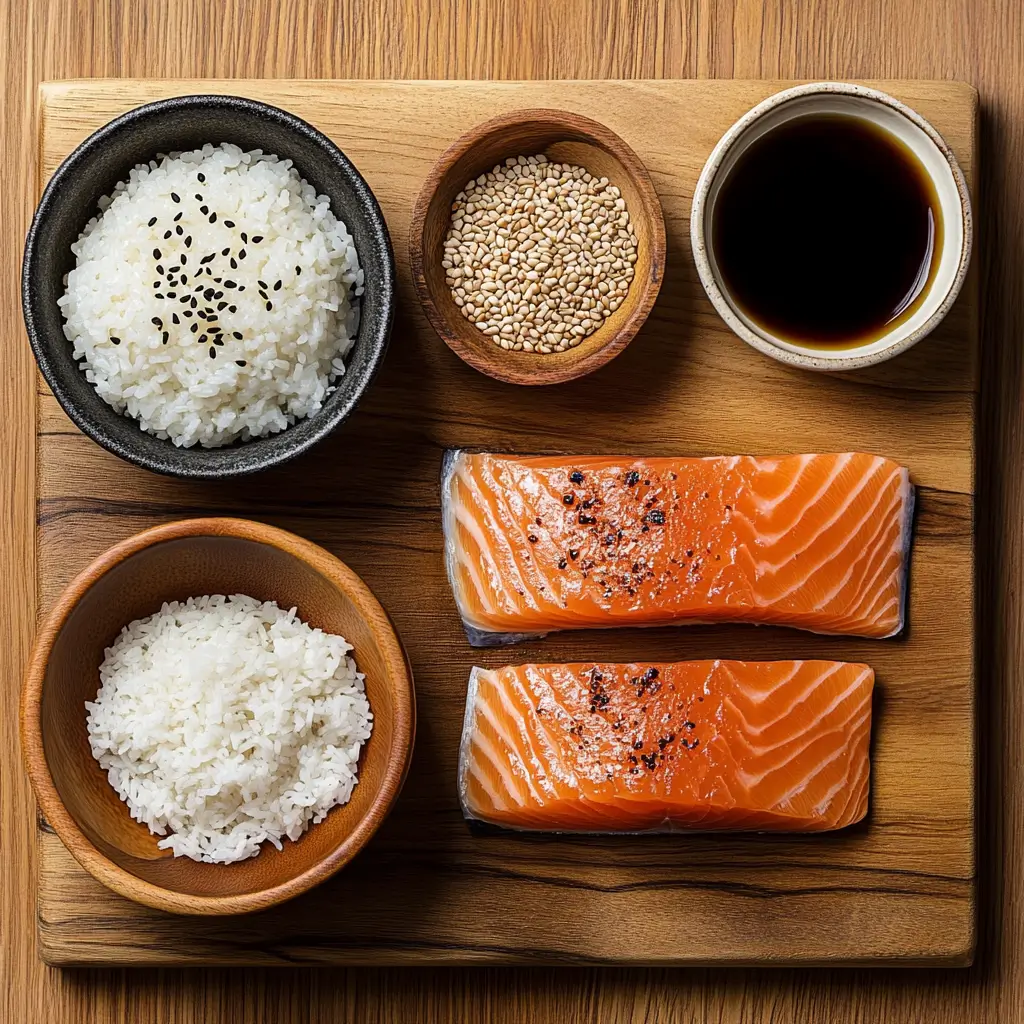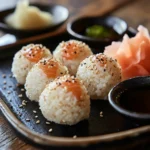Salmon rice balls, or salmon onigiri, are a classic Japanese comfort food enjoyed by people of all ages. They combine fluffy, seasoned rice with rich, flaky salmon, often wrapped in crisp nori for a delightful texture contrast. Whether you need a quick snack, a protein-packed lunch, or an easy meal prep idea, this salmon rice balls recipe will show you how to make them perfectly every time.
You’ll learn how to make rice balls that stick together, prevent them from drying out, and master the art of shaping them effortlessly.
Table of Contents
Why Are Salmon Rice Balls So Popular?
Salmon rice balls have been a beloved staple in Japanese cuisine for centuries. But what makes them so special? Let’s break down their enduring popularity.
A Flavor Combination That Just Works
The pairing of salmon and rice is a match made in culinary heaven. The slightly sweet, neutral taste of rice absorbs the rich, umami-packed flavor of salmon, creating a well-balanced bite. Moreover, the addition of nori (seaweed) enhances the overall depth, adding a salty, crisp texture that contrasts beautifully with the softness of the rice.
A Nutritious and Filling Snack
These Japanese rice balls offer a well-rounded nutritional profile. They provide:
Protein from salmon – Essential for muscle repair and satiety.
Healthy fats (Omega-3s) – Great for heart health and brain function.
Complex carbohydrates from rice – A steady source of energy.
Perfect for Meal Prep & On-the-Go Snacking
Unlike sushi, which requires precise rolling and fresh raw fish, salmon rice balls are much easier to prepare. You can make them in advance, pack them for work or school, and enjoy them at room temperature—making them a convenient, mess-free meal option.

Essential Ingredients for Perfect Salmon Rice Balls
Before we get into the step-by-step instructions, let’s go over the key ingredients that make salmon onigiri truly delicious.
Ingredient List
| Ingredient | Amount | Notes |
|---|---|---|
| Cooked sushi rice | 2 cups | Short-grain rice is best for stickiness |
| Salmon (grilled, baked, or canned) | 1 filet or ½ cup | Flaked into small pieces |
| Nori (seaweed) | 2-3 sheets | Optional for wrapping |
| Rice vinegar | 1 tbsp | Enhances flavor and balances sweetness |
| Salt | ½ tsp | Helps season the rice |
| Sesame seeds | 1 tbsp | Adds crunch and aroma |
| Soy sauce | 1 tbsp | Optional for seasoning |
By selecting the right ingredients and preparing them properly, you’ll set the foundation for making perfectly textured salmon rice balls that hold their shape.
Step-by-Step Guide: How to Make Salmon Rice Balls
Now that we’ve covered the ingredients, let’s move on to the step-by-step process of making Japanese rice balls with salmon filling.
Step 1: Cooking and Preparing the Rice
The key to a great salmon rice ball starts with the rice itself. Here’s how to prepare it properly:
- Rinse the Rice Thoroughly – Place the short-grain rice in a bowl, fill it with water, and swish it around. Drain and repeat until the water runs clear. This removes excess starch and prevents the rice from becoming overly sticky.
- Cook the Rice Properly – Use a rice cooker or stovetop method. Follow the correct water-to-rice ratio (typically 1:1 for Japanese short-grain rice).
- Season the Rice – While the rice is still warm, gently fold in the salt, rice vinegar, and sesame seeds to enhance flavor.
Pro Tip: Let the rice cool slightly before shaping. If it’s too hot, it will be difficult to handle.
Step 2: Preparing the Salmon Filling
The salmon filling can be prepared in a few different ways:
- Grilled Salmon – Season a fresh salmon filet with salt and grill until cooked through. Flake into small pieces.
- Pan-Seared Salmon – Cook the salmon in a pan with a little sesame oil for extra flavor.
- Canned Salmon – Drain well and season with a touch of soy sauce.
If you prefer a richer taste, mix the flaked salmon with a teaspoon of mayonnaise or a splash of soy sauce for added depth.
Step 3: Shaping the Rice Balls
Now comes the fun part—shaping your onigiri! Follow these simple steps for best results:
- Wet Your Hands – Dip your hands in a bowl of lightly salted water to prevent the rice from sticking.
- Scoop and Flatten – Take about ½ cup of rice and press it into your palm, forming a slight indentation.
- Add the Filling – Place a spoonful of flaked salmon in the center.
- Shape the Onigiri – Gently mold the rice around the filling, forming either a triangle or round ball shape.
- Wrap with Nori (Optional) – If using seaweed, wrap a strip around the rice ball for extra texture and flavor.
Pro Tip: Avoid pressing too hard—compact but light pressure ensures the rice ball holds together without being too dense.
How to Keep Rice Balls Moist and Prevent Drying Out
One common problem with salmon rice balls is that they can dry out over time. Here’s how to keep them moist and fresh:
Wrap Individually in Plastic Wrap – This helps retain moisture and prevents them from getting hard.
Use a Damp Paper Towel When Reheating – If microwaving, place a damp paper towel over them to keep them soft.
Store in an Airtight Container – Keep them in the refrigerator if not eating immediately.
How to Get Rice Balls to Stick Together?
If your Japanese rice balls keep falling apart, here’s what you need to check:
Use the Right Rice – Short-grain or sushi rice is naturally sticky and holds its shape well.
Work with Warm Rice – Cold rice loses stickiness, making it harder to mold.
Wet Your Hands Before Shaping – A little salted water prevents sticking and helps bind the grains together.
Common Mistakes When Making Salmon Rice Balls
Making salmon rice balls may seem simple, but a few common mistakes can impact their texture, flavor, and ability to hold their shape. By understanding these pitfalls, you can avoid frustration and ensure that your onigiri turn out perfectly every time.
Using the Wrong Type of Rice
One of the biggest reasons rice balls fall apart is using long-grain rice instead of short-grain Japanese rice. Long-grain rice, like basmati or jasmine, is drier and lacks the necessary starch to bind properly.
Solution: Always use short-grain or sushi rice. These types of rice contain more starch, making them naturally sticky and easier to mold.
Extra Tip: If your rice still feels too dry, add a teaspoon of water per cup of rice while cooking to improve its moisture content.
Overfilling the Rice Balls
It’s tempting to add a generous amount of salmon filling, but too much can prevent the rice from sticking together. If the filling overwhelms the rice, the ball will easily break apart when handled.
Solution: Stick to a teaspoon of salmon filling per rice ball to maintain a balanced ratio. This ensures there’s enough rice to encase the filling securely.
Pro Tip: If you love a more flavorful bite, mix a small amount of flaked salmon directly into the rice before shaping. This evenly distributes the flavor without risking structural integrity.
Not Wetting Your Hands Before Shaping
Rice is sticky! If you don’t wet your hands before handling it, the grains will cling to your fingers instead of forming a smooth ball.
Solution: Dip your hands into a small bowl of salted water before shaping. The water prevents sticking, while the salt subtly enhances the rice’s flavor.
Bonus Tip: Instead of plain water, use a light soy sauce solution (soy sauce mixed with water) for added depth of flavor.
Skipping the Seasoning
Many beginners forget to season their rice, assuming the filling will provide all the flavor. This often results in bland rice balls that lack depth.
Solution: Mix in a pinch of salt, a splash of rice vinegar, and a sprinkle of sesame seeds while the rice is still warm. This enhances the taste without overpowering the salmon filling.
Pro Tip: For extra umami, stir in a small amount of furikake (Japanese rice seasoning).
Using Cold Rice
Rice loses its stickiness as it cools, making it harder to mold into a compact shape. If your rice is too cold, it won’t hold together well.
Solution: Work with warm, freshly cooked rice. If your rice has been refrigerated, gently reheat it in the microwave with a damp paper towel to restore its moisture.
Pro Tip: If your rice feels too dry, lightly mist it with warm water before shaping.
Variations: Creative Ways to Enjoy Salmon Rice Balls
While traditional salmon onigiri is delicious on its own, there are many ways to customize and enhance its flavor. Try these creative variations for a fresh twist!
Spicy Salmon Onigiri
For those who love a kick of heat, spicy salmon onigiri is a must-try.
How to Make It:
- Mix flaked salmon with spicy mayo (a blend of Kewpie mayo and Sriracha).
- Add a pinch of shichimi togarashi (Japanese chili powder) for extra heat.
- Sprinkle with sesame seeds for added crunch.
Teriyaki Glazed Salmon Rice Balls
If you enjoy sweet and savory flavors, this teriyaki version is perfect.
How to Make It:
- Brush the rice balls lightly with teriyaki sauce.
- Pan-sear them for 1-2 minutes per side to create a caramelized crust.
- Sprinkle with toasted sesame seeds before serving.
Furikake and Avocado Onigiri
For a modern fusion twist, combine creamy avocado with Japanese furikake seasoning.
How to Make It:
- Mix diced avocado with flaked salmon.
- Sprinkle the rice balls with furikake (seaweed and sesame seasoning).
- Serve with a drizzle of soy sauce for added depth.
These variations ensure that your salmon rice balls remain exciting and flavorful, no matter how often you make them!
FAQs
To help you master salmon onigiri, here are answers to the most frequently asked questions.
How Do You Get Rice Balls to Stick Together?
✔ Use short-grain rice since it contains more starch, making it naturally sticky.
✔ Work with warm rice, as cold rice won’t bind properly.
✔ Apply gentle pressure when shaping, but avoid squeezing too hard.
Why Do Salmon and Rice Go So Well Together?
✔ Balanced Flavor: The richness of salmon complements the mild sweetness of rice.
✔ Soft & Fluffy Texture: The flakiness of salmon enhances the chewy consistency of short-grain rice.
✔ Versatility: Both ingredients can be seasoned in countless ways.
How Do You Keep Rice Balls Moist?
✔ Wrap them individually in plastic wrap if storing for later.
✔ Use a damp paper towel when reheating to retain moisture.
✔ Avoid overcooking the rice, as dry rice leads to dry onigiri.
How Do You Make Rice Balls Not Fall Apart?
✔ Ensure the rice is sticky enough—long-grain rice won’t work.
✔ Keep your hands wet when shaping to prevent sticking.
✔ Use just the right amount of filling—too much can break the rice apart
Can You Make Salmon Rice Balls Ahead of Time?
Yes! Salmon rice balls can be made in advance and stored properly.
✔ Storage Tips:
Wrap individually in plastic wrap and keep them in an airtight container in the fridge.
Consume within 24 hours for the best texture and flavor.
If reheating, microwave with a damp towel to prevent dryness.
Can You Freeze Salmon Rice Balls?
Yes, but freezing may slightly alter the texture.
✔ How to Freeze:
Wrap each rice ball tightly in plastic wrap to prevent freezer burn.
Store in a zip-top freezer bag for up to 1 month.
To reheat, microwave straight from frozen, covered with a damp paper towel.
Conclusion
Salmon rice balls are a delicious, convenient, and highly customizable Japanese dish. Whether you prefer the classic version or want to experiment with bold flavors like spicy mayo, teriyaki, or furikake, there’s a variation for everyone.
By following these tips, you can make perfect onigiri at home that are moist, flavorful, and structurally sound. Now, it’s time to try making your own!
Try making salmon rice balls today and enjoy a delicious homemade Japanese treat!
Print
Salmon Rice Balls Recipe: Easy, Delicious & Perfect Every Time!
- Total Time: 25 minutes
- Yield: 6-8 rice balls
Description
Salmon rice balls, or salmon onigiri, are a beloved Japanese snack that’s easy to make and packed with flavor. Featuring seasoned short-grain rice and flaky salmon, these handheld delights are wrapped in crisp nori for a perfect balance of taste and texture. Whether for meal prep, a quick snack, or a satisfying lunch, these salmon rice balls are a nutritious, protein-rich option that’s both filling and delicious.
Ingredients
- 2 cups cooked sushi rice (short-grain rice recommended)
- 1 filet salmon (grilled, baked, or canned; flaked into small pieces)
- 2–3 sheets nori (seaweed) (optional, for wrapping)
- 1 tbsp rice vinegar (enhances flavor and balances sweetness)
- ½ tsp salt (to season the rice)
- 1 tbsp sesame seeds (for added crunch and aroma)
- 1 tbsp soy sauce (optional, for seasoning the salmon)
Instructions
Prepare the Rice:
- Rinse the rice under cold water until the water runs clear to remove excess starch.
- Cook the rice using a rice cooker or stovetop method (use a 1:1 water-to-rice ratio for best results).
- While the rice is still warm, gently fold in the salt, rice vinegar, and sesame seeds.
Prepare the Salmon Filling:
- For grilled or baked salmon: Cook the salmon filet until fully done, then flake it into small pieces.
- For canned salmon: Drain well and season with a small amount of soy sauce for added flavor.
- Optionally, mix the flaked salmon with a teaspoon of mayonnaise for a creamy texture.
Shape the Rice Balls:
- Wet your hands with a little salted water to prevent sticking.
- Take about ½ cup of rice and gently press it into your palm, creating a slight indentation.
- Place 1 teaspoon of flaked salmon in the center.
- Shape the rice around the filling, forming either a triangle or round ball shape.
- Wrap with a strip of nori if using.
Serving & Storage:
- Enjoy immediately or store in an airtight container.
- To keep rice balls moist, wrap them individually in plastic wrap or store in an airtight container.
- If reheating, cover with a damp paper towel in the microwave to prevent drying out.
Notes
- How to Keep Rice Balls Moist: Wrap them individually in plastic wrap to retain moisture and prevent drying out.
- For Extra Flavor: Mix some salmon directly into the rice before shaping for even distribution.
- Variations:
- Spicy Salmon Onigiri: Mix salmon with spicy mayo (Kewpie + Sriracha).
- Teriyaki Glazed Rice Balls: Lightly brush the rice balls with teriyaki sauce and pan-sear for a crispy caramelized coating.
- Avocado Furikake Onigiri: Add diced avocado and sprinkle with furikake for a modern twist.
Enjoy these easy-to-make and versatile salmon rice balls for any occasion!
- Prep Time: 15 minutes
- Cook Time: 10 minutes
- Category: Dinner
- Cuisine: Japanese
Nutrition
- Calories: ~180 kcal
- Fat: 5g
- Carbohydrates: 25g
- Protein: 10g

2 thoughts on “Salmon Rice Balls Recipe: Easy, Delicious & Perfect Every Time!”